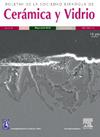微波辅助水热合成纳米氧化锆
IF 2.7
4区 材料科学
Q1 MATERIALS SCIENCE, CERAMICS
Boletin de la Sociedad Espanola de Ceramica y Vidrio
Pub Date : 2025-06-05
DOI:10.1016/j.bsecv.2025.100445
引用次数: 0
摘要
以ZrOCl2·8H2O和KOH为原料,建立了一种简单、快速、高效的微波水热法制备纳米氧化锆的方法。在180℃下,通过直接分解ZrOCl2·8H2O(样品Z)和用KOH沉淀ZrOCl2·8H2O并脱水(样品ZK)两种方式合成。将合成的粉末在500℃下煅烧,并用XRD、FE-SEM、HR-TEM和SAED对产物进行了表征。合成的纳米粒子和煅烧的纳米粒子都是高度结晶的。样品Z以单斜相为主,样品ZK以四方相为主,单斜相较少。合成样品Z的颗粒形状呈不规则和半六边形,但在热处理过程中颗粒形状变为球形或椭球形。样品ZK的颗粒,无论是合成的还是煅烧的,都呈现出接近球形或椭球体的形状。合成样品Z和ZK的平均晶粒尺寸分别为3.2±0.8和5.5±0.9 nm,煅烧样品Z和ZK的平均晶粒尺寸分别为8.5±1.2和7.6±1.2 nm。本文章由计算机程序翻译,如有差异,请以英文原文为准。
Microwave-assisted hydrothermal synthesis of nanocrystalline zirconia
A simple, fast and energy efficient microwave-assisted hydrothermal method was developed for the preparation of nanocrystalline zirconia from commercially available ZrOCl2·8H2O and KOH. The synthesis was conducted at 180 °C for 20 min by two ways: direct decomposition of ZrOCl2·8H2O (sample Z), and precipitation of ZrOCl2·8H2O with KOH and dehydration of hydroxides (sample ZK). The as-synthesized powders were calcined at 500 °C, and all the resulting products were characterized by XRD, FE-SEM, HR-TEM and SAED. Both the as-synthesized and calcined nanoparticles were highly crystalline. A single monoclinic phase was obtained for sample Z, while for sample ZK a tetragonal phase was achieved as the main phase with a minor fraction of monoclinic. The particles of the as-synthesized sample Z showed irregular and semi-hexagonal shapes, although they changed to spherical or ellipsoidal shapes during heat treatment. The particles of the sample ZK, both as-synthesized and calcined, exhibited nearly spherical or ellipsoidal shapes. The average crystallite size for the as-synthesized samples Z and ZK were 3.2 ± 0.8 and 5.5 ± 0.9 nm, respectively, while for the calcined ones the values were 8.5 ± 1.2 and 7.6 ± 1.2 nm, respectively.
求助全文
通过发布文献求助,成功后即可免费获取论文全文。
去求助
来源期刊

Boletin de la Sociedad Espanola de Ceramica y Vidrio
工程技术-材料科学:硅酸盐
CiteScore
5.50
自引率
2.90%
发文量
72
审稿时长
103 days
期刊介绍:
The Journal of the Spanish Ceramic and Glass Society publishes scientific articles and communications describing original research and reviews relating to ceramic materials and glasses. The main interests are on novel generic science and technology establishing the relationships between synthesis, processing microstructure and properties of materials. Papers may deal with ceramics and glasses included in any of the conventional categories: structural, functional, traditional, composites and cultural heritage. The main objective of the Journal of the Spanish Ceramic and Glass Society is to sustain a high standard research quality by means of appropriate reviewing procedures.
 求助内容:
求助内容: 应助结果提醒方式:
应助结果提醒方式:


